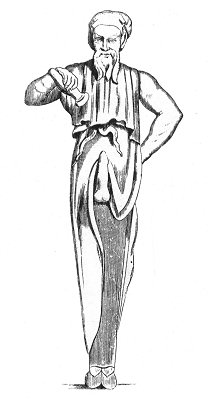
Plate XV.
BRONZE. Of the size of the original.
PLATE XV.
NO doubt this bronze, which was found at Portici, must have belonged to a votive chapel. It represents an old man whose beard is carefully combed; his ears, of considerable dimensions, resemble those of a faun. He is clad in the dress called talare, tied round his loins. His legs seem set in a sheath, and his feet are shod; his tunic is turned up; his left hand rests on his hip, and with his right hand he pours the contents of a vase of essences on his phallus. This part of the statue is out of all proportion. The vase is supposed to contain one of those compounds to which was attributed the property of restoring to the athletes of Venus their pristine vigour.
The ancients delighted in mixing aphrodisiac beverages, or what were held as such, to which the Greeks gave the name of satyrion.
Theophrastus, Dioscorides, and Pliny 1 speak complacently of the essences and ointments which had the property of giving extraordinary Vigour to the male.
It appears, according to these authors, that the tubercles of the orchis hircina served as the basis of aphrodisiac preparations. The enchantresses of Thessaly dissolved fresh tubercles of this plant in goat's milk, and thus produced a beverage which they gave to worn-out old men to rekindle the flames of love in them. On the other hand, in order to produce a contrary effect and to extinguish immoderate fires, they made use of tubercles, which being upwards of a year old, were withered and dry. If we may credit the mythologists, it was by the aid of such an ingredient that Hercules, having received the hospitality of Thespius, showed his gratitude to him by ravishing the fifty daughters of his good host in a single night. Proculus, having taken a hundred young virgins prisoners, deflowered them all round in fifteen days. A King of India, named Androphilus, having sent to Antiochus a plant of the satyrion species, Theophrastus declares that the slave entrusted with this wonderful product boasted of having, by its means offered seventy sacrifices to Venus in succession. 1
The Egyptians call a plant which they consider as aphrodisiac, chanlendjâam-dgarbi. This is the maranta-galanga of Linnæus.
Only a few years ago there were still to be found in the pharmacopoeia electuaries and preparations supposed to possess the same property. In the first rank there figured a kind of lizard, a native of Africa, the scincus officinalis. Taken in the form of powder, it was considered as a powerful auxiliary in amorous combats. The merchant ships returning from Alexandria to Marseilles brought back bottles of them, in which these animals were packed together like anchovies.
Cantharides, truffles, aromatics, several species of mushrooms, and
in particular one description, are looked upon as aphrodisiacs. Monsieur Descourtilz, in speaking of the last-named mushroom, in his "Picturesque Flora of the Antilles, says:--"Careful housewives give their lovers plenty of it to eat, as an erotic incentive." And further on he adds: "This species is looked upon as an aphrodisiac, and matrons do not fail to garnish with it the dishes of young adepts whom they destine to the first sacrifice to Venus and to revive the torpid spirit of old stagers who can do nothing but exhibit the same inefficiency over and over again. The pimento, nutmeg, clove, cinnamon, and ginger mixed with it, add to the aphrodisiac virtue of this extraordinary mushroom, and the whole would almost raise a dead man from his grave." 1
Whatever may be the virtue of these preparations, we can only deplore the infatuation of those unhappy persons who venture to have recourse to them. The use of these factitious means, and the venereal excesses they cause, cannot but lead in a very short time from satiety to despair, and from despair to death.
Temperance and sobriety can alone defer the term when our amorous combats must cease.
NOTE.--There exists in the same museum another statuette similar in everything but the base to that we have just described.
32:1 THEOPH. Op.; DISCOR. iii. 134; Pliny xxvi. 10.
33:1 THEOPHR. Hist. ix. 19.
34:1 A story is related, on this subject, of two young girls, fast linked in friendship who were married on the same day. In a moment of enthusiasm, they pledged themselves on oath to tell each other every morning the number of amorous tributes paid them by their husbands during the night. And so they did. On the morning after their nuptials, the newly-married women, who lived opposite each other, stood at their respective windows, and exchanged the signs they had agreed upon between them. With an air radiant with gladness, the first lifted both hands and showed ten fingers. The second, blushing and with a drooping head, showed only one "Poor child," exclaimed her neighbour to herself, p. 35 I pity you indeed to be so badly matched." The following day the same scene took place, at which the happier of our belles showed only nine fingers, whilst the other still showed only one. On the third day the first showed eight, on the fourth seven, on the fifth six, and on the sixth five, and so on, descending in proportion every day, whilst her neighbour still continued to show only one finger. These manœuvres lasted as long as the happier one had something to show and to boast of, but she shortly after discontinued, and showed her friend only her clenched hands, a sign of anger as well as impotency, The other, however, now raised her head proudly, for she was at least able to show that her daily allowance was still being supplied her with the most scrupulous exactitude.